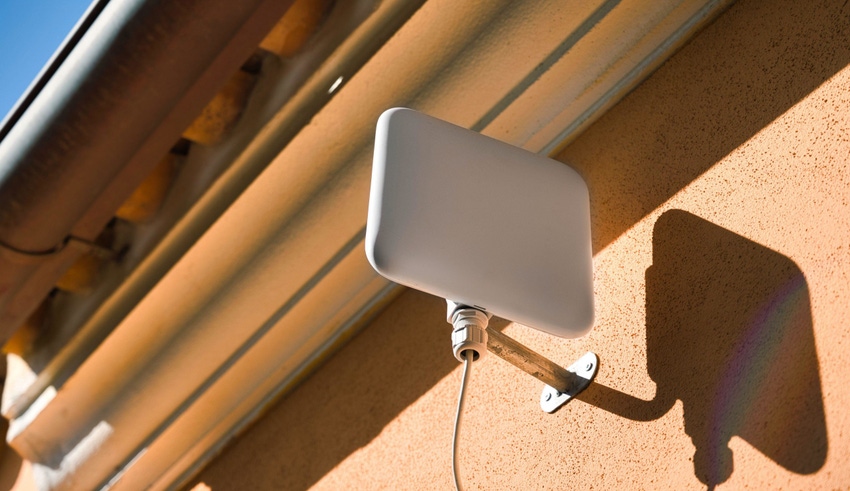Fixed Wireless Access (FWA) is considered by some in the industry to be an efficient broadband alternative, especially since the dawn of 5G and mmWave spectrum allocations.
February 9, 2023

Fixed Wireless Access (FWA) is considered by some in the industry to be an efficient broadband alternative, especially since the dawn of 5G and mmWave spectrum allocations.
With FWA technology, connectivity to the premise is typically serviced via an outdoor antenna called a customer premise antenna (CPA), providing wireless connectivity in a fixed-like manner to the end-user. This enables the operator to link its radio systems with the customer’s premise, which will then feed connectivity through an indoor customer premise equipment (CPE).
It is worth noting that some telecom organisations will also define reusing a mobile broadband subscription paradigm as a ‘Best Effort’ FWA. Though this method cannot guarantee continuous quality of service as the customer theoretically could move the CPE to other locations and receive varying signalling.
This piece of analysis aims to investigate the long-term market potential of 5G FWA, exploring its use-cases and comparing how it fares against other front-running fixed-line broadband technologies.
The rise of FWA
Historically, FWA utilised WiMax or proprietary technologies as the access wireless technology. However, with the rise of LTE in the past decade more markets have disconnected those technologies in favour of it, and more recently 5G.
Today, data from research firm Omdia points out that FWA makes up around 3.5% of the global fixed broadband subscribers, with the majority of FWA connections still serviced by LTE. This figure is forecast a moderate continuous annual growth rate (CAGR) of 13% between 2022 and 2027. Despite this growth, FWA remains only the fourth biggest access technology for the provision of fixed broadband today (and by 2027) behind fibre, cable, and xDSL. Meanwhile, fibre dominates the fixed broadband market globally with around two in three subscriptions.
In terms of market size and demand for the technology, several research firms are estimating the global market size for 5G FWA to exceed $23 billion between 2025 and 2027.
5G FWA vs FTTH on speed and capacity
Typical speeds of a fibre-to-the-home (FTTH) connection range between 100 Mbps uplink to 500 Mbps with downlinks reaching up to 1000 Mbps. Such fibre-like speeds can theoretically be reached with FWA based on standalone 5G network using an outdoor CPA. Meanwhile, a 5G radio connected to an indoor CPE only, i.e. Best Effort FWA, can reach maximum speeds in the region of 100 Mbps, according to Ericsson. As the momentum behind passive optical gigabit networks grows and guaranteed minimum speeds become part of the pricing model, any FWA service will need to keep pace ensuring service quality.
To date, the majority of 5G FWA deployments have focused on the 3.5-3.8 GHz frequency bands. This is because these bands provide a fair coverage with what is cited as ‘good’ throughput rates (of course depending on MHz block size). However, organisations such as the GSMA argue that mmWave spectrum can provide a great bandwidth boost, similar to fibre optic, and thus, could be deployed on top of existing sites (serviced by sub 6 GHz) to fill any capacity gaps.
It is worth noting here that mmWave provides weak coverage propagation and it has been argued its range is more suited for densely populated areas such as cities or suburban locations that would benefit from its high throughput, though issues related to line of sight may need to be taken into account.
The dawn of 5G FWA has also introduced more spectral efficiency than previous LTE or proprietary technologies. Improvements in signalling and the CPE used for 5G FWA enable the use of massive MIMO (defined as: a wireless network that allows the transmitting and receiving of more than one data signal simultaneously over the same radio channel), beamforming techniques, and sound reference signal that allows the CPE to switch between beams to optimise its signal.
Bridging the rural-urban divide and other use-cases
Bridging the digital divide between rural communities and more densely populated areas is a frequently debated topic with regards to the commercial viability of high-speed broadband network expansion into remote and low-density areas. Covering the last mile via cable or fibre to premises is often viewed as costly with perceived barriers including the distance between the roads where the cabinets are and the premises. Satellite or xDSL alternatives are thought to lag behind in terms of latency and speed, respectively.
FWA is considered one of the key 5G use cases by the industry and many proponents also believe it can unlock the connectivity coverage objectives many regions have set for decades. As such many argue rural communities to be a great use case for FWA and a viable alternative. This, however, relies on the assumption that mobile networks, including standalone 5G, indeed cover a 100% of households, including those in remote and rural areas, in a given market. Meanwhile, a study commissioned by the EU raises concerns over further rural-urban digital divide as the continent seems to predominantly deploy urban-centric 5G rollout.
Another FWA use case is in the scenario of decommissioning of copper lines which have for a long time served as the traditional technology in many parts of Europe (including Germany and the UK). This would allow operators to accelerate the provision of faster speeds. Industry specialists have argued that offering FWA in such instances could act as an interim solution to bridge the speed gap until sufficient fibre was laid out to offer FTTH. This would ultimately also allow operators to repurpose the FWA network for their mobile services again.
Finally, FWA is argued as a viable route for a mobile-only operator with existing infrastructure to enter the fixed-line market without the need for much additional investment.
Short-term cost saving vs long-term cost efficiency
The main upfront costs related to FWA coverage requirements typically are associated with towers, shelters, backhaul, and basebands. Operators with existing assets and excess capacity are thought to have virtually zero additional costs when offering FWA along with their mobile proposition. Though some additional costs for an existing mobile operator will include the indoor CPE which is also considered more expensive than fibre network terminals. Those offering FWA via an outdoor CPA will additionally require engineer installations which will accrue labour and material costs.
Through targeted deployments, some vendors argue, any additional investments into FWA can pay off in less than two years. The GSMA, an organisation which represents the interests of mobile network operators (MNOs), estimates up to 80% cost saving through the deployment of FWA versus FTTH in rural settings, 60% savings in suburban, and 35% savings in urban settings. In terms of absolute capex for existing mobile players this makes sense.
Meanwhile, in terms of opex and long-term maintenance costs, it is unclear whether the initial cost savings can outperform the return on investments made by technologies such as FTTH. Additionally, the Fiber Broadband Association argues that in the long-term fibre is a more cost-effective solution than FWA. This, it states, is due to dependencies associated with the wireless technology including, greater risk of interference, line of sight vulnerable to foliage, construction material, and whether conditions, tower and antenna capacity, and dependencies associated with backhaul support.
Conclusion
To sum up, FWA, based on 5G technology, has a number of strengths including the ability to reach fibre-like speeds especially if deployed via an outdoor antenna; high throughput in combination with mmWave; and finally, percentage of saving on upfront capex in comparison to FTTH deployments for existing mobile operators with excess capacity. Combined, these benefits can act as part of an efficient road-to-market strategy, especially for MNOs with no other fixed-line assets.
The optimal use-cases seem to include the following:
last mile solution in rural areas with mobile coverage for those MNOs with excess capacity (or in cities where mmWave is available);
as a temporary solution for to offer fibre-like speeds for service providers phasing out copper-lines, before while they deploy optical fibre lines;
and finally, as a fast route to market-entry for mobile-only operators or enterprises (private 5G).
On the flip side though, sight of line and guaranteed minimum speeds remain part of the key limitations when compared to passive optical networks. This indicates that despite the short-term gains FWA (5G or not) offers, the technology isn’t as strong a competitor to FTTH, especially considering that to support the rates that SA 5G promises and to increase the reach of the network a strong fibre backhaul still needs to be deployed.
Get the latest news straight to your inbox. Register for the Telecoms.com newsletter here.
About the Author(s)
You May Also Like








.png?width=300&auto=webp&quality=80&disable=upscale)


_1.jpg?width=300&auto=webp&quality=80&disable=upscale)


.png?width=800&auto=webp&quality=80&disable=upscale)